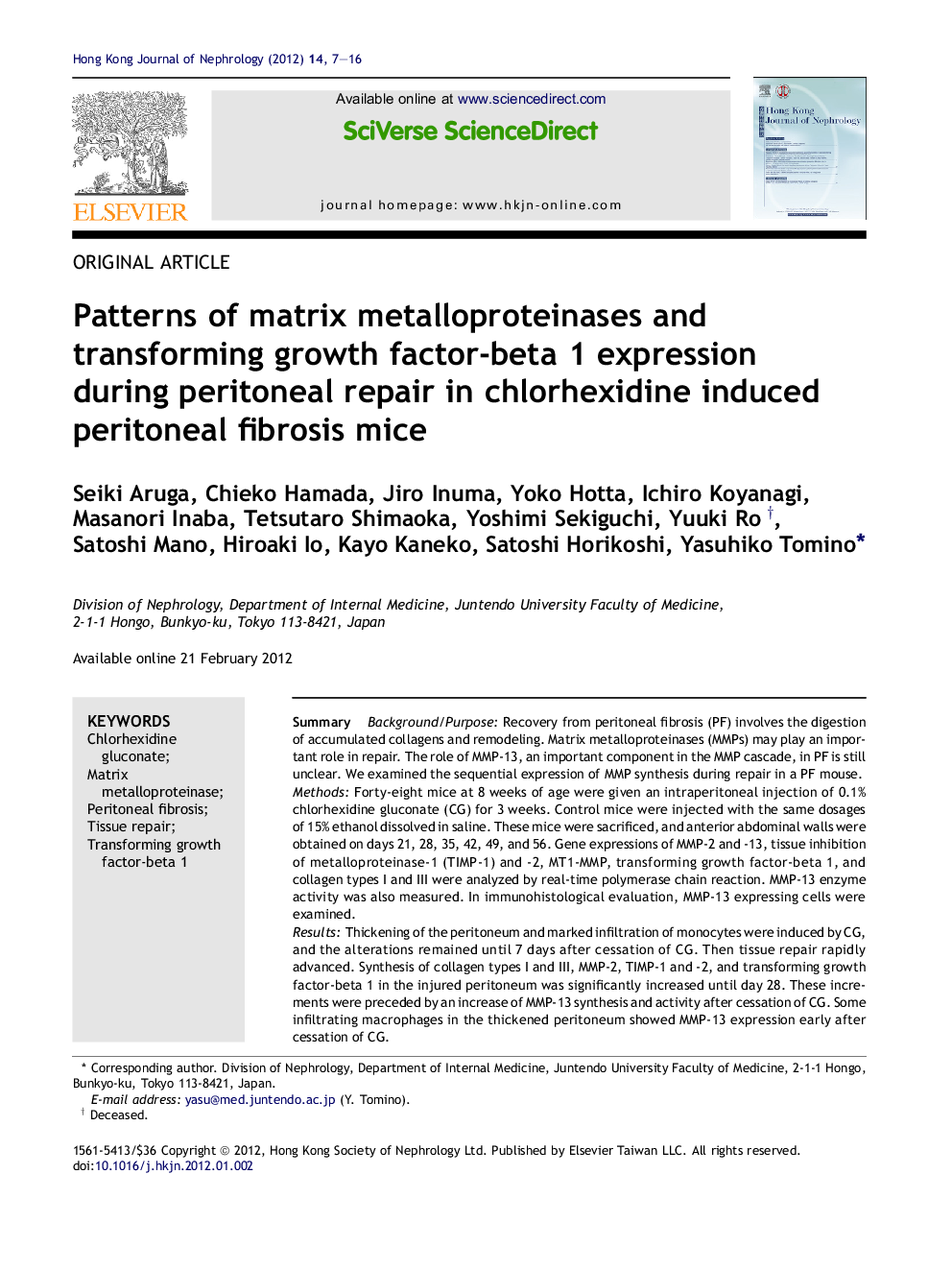| کد مقاله | کد نشریه | سال انتشار | مقاله انگلیسی | نسخه تمام متن |
|---|---|---|---|---|
| 3854000 | 1598548 | 2012 | 10 صفحه PDF | دانلود رایگان |

SummaryBackground/PurposeRecovery from peritoneal fibrosis (PF) involves the digestion of accumulated collagens and remodeling. Matrix metalloproteinases (MMPs) may play an important role in repair. The role of MMP-13, an important component in the MMP cascade, in PF is still unclear. We examined the sequential expression of MMP synthesis during repair in a PF mouse.MethodsForty-eight mice at 8 weeks of age were given an intraperitoneal injection of 0.1% chlorhexidine gluconate (CG) for 3 weeks. Control mice were injected with the same dosages of 15% ethanol dissolved in saline. These mice were sacrificed, and anterior abdominal walls were obtained on days 21, 28, 35, 42, 49, and 56. Gene expressions of MMP-2 and -13, tissue inhibition of metalloproteinase-1 (TIMP-1) and -2, MT1-MMP, transforming growth factor-beta 1, and collagen types I and III were analyzed by real-time polymerase chain reaction. MMP-13 enzyme activity was also measured. In immunohistological evaluation, MMP-13 expressing cells were examined.ResultsThickening of the peritoneum and marked infiltration of monocytes were induced by CG, and the alterations remained until 7 days after cessation of CG. Then tissue repair rapidly advanced. Synthesis of collagen types I and III, MMP-2, TIMP-1 and -2, and transforming growth factor-beta 1 in the injured peritoneum was significantly increased until day 28. These increments were preceded by an increase of MMP-13 synthesis and activity after cessation of CG. Some infiltrating macrophages in the thickened peritoneum showed MMP-13 expression early after cessation of CG.ConclusionMMP-13 was synthesized by infiltrating monocytes early in the repair process in the CG-induced PF mouse. After cessation of stimulant, increase of MMP-13 synthesis may act as an inducer of an efficient degradation cascade in collagen-rich peritoneal tissue.背景腹膜纖維化的復原涉及膠原蛋白堆積的消化與其後的重塑,其中,基質金屬蛋白酶(MMPs)在組織修復期間可能佔有重要的角色。作為MMP級聯中的重要一環,MMP-13在腹膜纖維化上的角色仍然未明。本研究透過腹膜纖維化(PF)的小鼠,調查了在腹膜修復期間MMP生成的表現順序。方法研究材料為48隻年齡8週的小鼠,先接受每天共3週的0.1%葡萄糖酸氯己定(CG)腹膜內注射;另外對照組的注射則採用相同容量or劑量含15%乙醇的鹽水。其後陸續宰殺小鼠以取得第21、28、35、42、49及56天的前腹壁檢體,並採用實時PCR測量以下的基因表現:MMP-2-13、TIMP-1-2、MT1-MMP、TGF-β(1)、及I III型膠原蛋白。此外亦同時測量MMP-13之酵素活動,並對表現MMP-13的細胞作免疫組織學評估。結果在CG誘導下,可見腹膜增厚及單核球的明顯浸潤,直至停止CG後7天,其後可見組織修復的快速進行。在停止CG後的受損腹膜中,首先可見MMP-13生成與活動的增加,其後亦可見I III型膠原蛋白、MMP-2、TIMP-1-2、及TGF-β(1)生成的明顯增加,直至第28天。在停止CG後的早期,可見增厚腹膜中有若干巨噬細胞具MMP-13表現。結論在CG所致的PF小鼠中,腹膜修復早期已可見浸潤的單核球產生MMP-13。在停止刺激後,在富含膠原蛋白的腹膜環境中,MMP-13似乎可促使一個高效降解級聯的進行。
Journal: Hong Kong Journal of Nephrology - Volume 14, Issue 1, April 2012, Pages 7–16